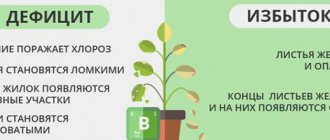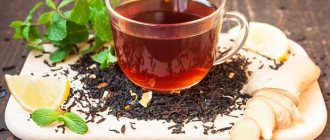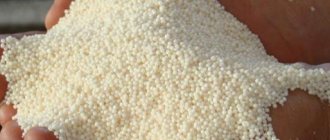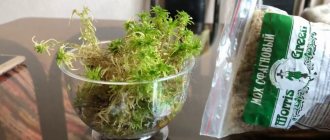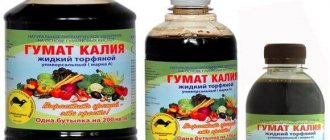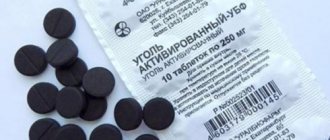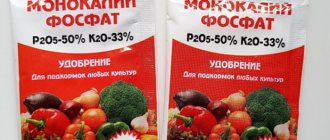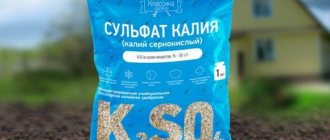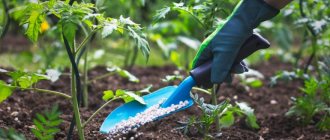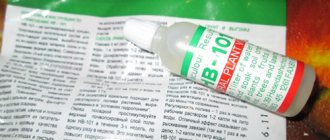Potassium humate liquid - application for different types of plants
The instructions for using potassium humate indicate the dosage, method of dilution and features of use for different types of crops.
The drug is sold in both small bottles and canisters and is a brown liquid. This is a concentrate that is diluted with plain water before use - just add 0.1-0.2% of the substance. Further, the working solution can be used in different ways:
- Soaking seeds is a procedure that significantly improves germination rates. It is enough to soak the bulbs in a diluted solution for 8 hours, the seeds for 24 hours. Seeds of cucumbers and ornamental flowering plants can be left for 2 days.
- Spraying is the easiest way to apply fertilizer. The substance is perfectly absorbed through the green mass of plants and is used to maintain biochemical processes. The solution is distributed from a spray bottle using a respirator and a protective suit. For potted plants, you can take a bottle with a special spray nozzle.
- Watering - this method of applying fertilizer is used if there is a need to improve the properties of the soil. It is better to carry out the procedure in early spring, several times with an interval of 10 days. For one plant you can add from 500 ml to 1 liter of working solution of potassium humate.
- Soil treatment - for this method it is better to purchase fertilizer in powder form. It is combined with ordinary sand and scattered over the surface of the soil in early spring. For 10 m2, 50 g of the drug is enough. The substance will be absorbed into the ground with melt water, but you can also apply it in the warm season, and then dig up the area.
Dosages for different types of plants
Potassium humate is a universal fertilizer that is useful for different crops
For each of them, it is important to follow a feeding schedule so that the plants receive a sufficient amount of nutrients.
Experienced gardeners recommend adhering to the following schedule:
carrots, zucchini, white cabbage, beets - 4 sprays per season, as well as soil treatment before planting; potatoes - additional soaking or spraying of tubers before planting in the ground; cucumbers and tomatoes - at least 3 sprays during the warm season, soaking the seeds; greens - watering in the amount of 3-10 liters per meter of planting;
fruit and berry plants - it is important to apply fertilizers in early spring, as well as during the period of flowering and fruit set; indoor plants - 1 spraying every 2 weeks during the warm season, 1 spraying per month in winter.
Liquid potassium humate is a useful additive that improves the endurance and productivity of crops. It can also be used for ornamental plants, since humus is not produced in pots. The instructions for use indicate how to dilute potassium humate for indoor flowers, vegetable and fruit crops, garden plants and herbs. The product is stored in concentrated form, so for treating large areas it will be needed in a minimal amount.
Areas of use
Gardeners use potassium humate when needed:
- Prepare seeds for planting. For this purpose, the drug is recommended in liquid form.
- Feed the seedlings.
- Water plants or seedlings in the garden and greenhouse.
- Treat crops during flowering and fruiting periods. A weakly concentrated solution (0.1%) is used, intended for spraying.
- Carry out soil reclamation.
- Treat organic fertilizers (humus or manure).
Treatment of an annual plant should occur at the beginning of the growing season - the formation of inflorescences. The use of potassium humate fertilizer after planting or replanting is necessary to restore the damaged root system.
Humates should be added to pre-moistened soil. The powder-based solution is left to stand for two days. The greatest efficiency is observed when used indoors.
Pre-sowing preparation
It is based on the use of liquid potassium humate. Time frame for soaking seeds:
- tomatoes – 3 days;
- cabbage – 2 days;
- other vegetable crops – 1 day;
- potatoes – half a day;
- cuttings (to take root better) - for a day.
Growing seedlings
Potassium humate helps not only young crops. It helps to increase resistance to diseases and pests, and the negative effects of the environment in seedlings. The drug also increases the survival rate of the crop after planting in the garden beds.
Liquid humate is more suitable for seedlings. If you give preference to the powder form, then loosening the soil is required, which in this situation can lead to damage to the immature roots of the plant. Before planting seedlings, you can add a ready-made solution or powder to the hole. The dosage is adjusted according to the instructions indicated on the package.
Potassium humate - use “not according to the rules”
Liquid and solid
Whether you use liquid humate or powder does not really matter. Anyway, it is added in the form of a solution with a low concentration of the active substance. The main advantage of the powder substance is ease of transportation and storage. It is much more important to know what kind of potassium humate you have:
- ballast;
- ballastless;
Ballast is used as a fertilizer, and non-ballast is used as a growth stimulator. But this division is to some extent formal. After all, the effect of humic preparations on plants is the same in both cases.
Features of sodium humates
Just in case, let's pay attention to sodium humate. It is ideal for processing tomatoes, beets
But excess sodium has a depressing effect on other crops, so do not overuse treatments. This type of humic fertilizer is the cheapest to produce, so they are widely used, despite some specificity. And the method of using them is the same.
Potassium humate liquid - application and origin
Peat humate and those obtained from coal are slightly different. Over time, water washes out fulvic acids from coal. Humic acids are large, unwieldy molecules. Water can’t wash them out, so they don’t go anywhere. Therefore, many farmers prefer peat and use liquid peat potassium humate. Liquid, by the way, because this form is more convenient. The above does not mean at all that the effect of using a solution of liquid peat preparation will necessarily be better. It all depends on your goals. For example, humic acids bind toxic substances well in the soil. In this case, the low content of fulvic acids is definitely not a disadvantage. On the other hand, in Lignohumate the proportion of fulvic acids in humic substances reaches 40% - more than in peat stimulants.
Advantages
The use of Humate +7 significantly increases harvest volumes. The drug promotes the development of a powerful root system and rapid growth of green mass, an increase in the number of ovaries and the size of fruits, and accelerates their ripening.
Humate improves the composition and structure of even poor, severely depleted soils.
In addition to its high effectiveness, the product has significant advantages:
- Versatility. The drug is suitable for feeding any crops at all stages of development.
- Food availability. Microelements in Humate +7 are in chelated forms, to which plant roots are most susceptible. The effect of application in the early stages appears already by the middle of the growing season.
- Safety. The product is marked with hazard class 4. This means that it is harmless to people, animals, birds, and beneficial insects. Humate does not pollute the soil with toxins and harmful substances; on the contrary, it neutralizes the effect of nitrates and salts of heavy metals.
- Ease of use. You can apply fertilizer in any way - by spraying, watering at the root, or incorporating it into the soil. Various release forms are available to the consumer.
- Compatibility. The neutral composition of Humate +7 allows it to be used together with most other products - fertilizers, pesticides, immunomodulators, growth stimulants. But there are exceptions.
World of humates
Humates are a subtype of humic substances found in transformed organic matter: in soil and lake silt, in peat and humus, and in addition, in fossilized plant remains - coal deposits. It is from such concentrated organic matter that manufacturers extract humic acids, and then combine them with sodium or potassium alkali. As a result of chemical reactions, special soluble salts are formed at the output - sodium or potassium humates.
There are no major differences between these two products. They are similar in their main properties and can replace each other.
Sodium humate is usually slightly cheaper in cost. It protects plants well from various stress factors (temperature, water exchange, infectious and many others). It is alkaline on the pH scale.
Potassium humate exhibits a neutral pH and a slightly wider range of influence. According to the instructions, it is especially useful for pre-sowing and pre-planting treatment (seed material, bulbs, tubers, etc.), for rooting seedlings, strawberry tendrils, and various cuttings. Possible joint use with other substances (fertilizers, microelements, many fungicides and pesticides).
If you look at the instructions as a whole, the differences between potassium and sodium humic salts are not too great. But the quality of the drug plays a decisive role. The products that are truly effective in use are those that are most fully absorbed by plants and have a high concentration of active substance.
Not very conscientious entrepreneurs can dilute ordinary cheap peat with water and call this product “humic fertilizer.” Formally, there is nothing to complain about: there are humic compounds there (as in any soil, swamp slurry, or piece of brown coal). However, the effectiveness is questionable. Large research and production companies create humic preparations using special technologies, focusing on high concentration and successful absorption of the substance by cultivated plants and soil inhabitants.
Advantages of good humates
- Low cost compared to other stimulants and fertilizers.
- Significant economic benefits (2 rubles of costs bring 100 rubles of income - a direct increase in yield and improvement in the quality of agricultural products).
- The shelf life and shelf life are not limited (although some instructions contain instructions for specific periods of use).
- Ease of use.
- Safety from an environmental point of view (for high-quality drugs purified from possible heavy metal impurities).
- Overdose is not dangerous.
- Can be used throughout the season.
- Good compatibility with many drugs.
- Universality in a broad sense: there are no restrictions on place, time, culture.
Principle of operation
The physicochemical mechanism of behavior for molecules of humic substances has not been fully studied, but scientists have determined that they resemble activated carbon: they attract and bind other molecules. From the seed or tuber they take chemical compounds that inhibit germination. Humates in a special way (like hormones) open the cell membranes of plants, improving the penetration of nutrition, but blocking access to infections and poisons. In the internal environment of plants, water metabolism and circulation of nutrients are improved. When humic compounds enter the soil, they attach to hazardous substances (pesticides, heavy metals, etc.) and reduce their harmful effects on the ecosystem.
Types of drugs: composition and characteristics
The list of the most effective and popular fertilizers based on potassium humate is discussed in more detail below.
Universal
Universal potassium humate has a beneficial effect on plant growth, reduces soil acidity and accelerates metabolic processes. The fertilizer has the following composition:
- a large number of humic compounds;
- substances that are growth stimulants, peptides;
- wax, fat, antibiotics;
- essential amino acids and enzymes.
Potassium ensures the normal process of photosynthesis, sugar formation and the entry of carbohydrates into the plant. Mineral fertilizer can be used to treat seeds, cuttings, and adult crops when using a certain concentration of the product.
Fertilizer must be applied directly to organic compounds, since when planted in black soil, the solution will not have the desired effect.
Liquid peat
Liquid peat humate has a considerable number of positive reviews regarding the degree of effectiveness of the product. Dark brown liquid with a high content of active compounds (up to 80%) and natural peat.
The composition also contains essential minerals and organic substances. The fertilizer is easy to use and quickly gives the desired effect:
- Fertilization of plant crops is carried out with a solution with a concentration of no higher than 0.01% (soaking seeds, planting, fertilizing, spraying on the top part);
- improvement of the general condition of the soil with a solution of 0.2%;
- the drug can be used in combination with pesticides, nitrogen fertilizers, and organic compounds; the exception is phosphorus compounds, since when mixed with potassium they form insoluble substances;
- the use of fertilizer in an integrated crop care scheme ensures an increase in yield and helps reduce the use of various nitrates and toxins.
Peat powder
Peat humate powder dissolves well in water and forms a suspension of useful minerals. Advantages when using:
- increasing germination and further growth of planting material;
- stimulation of the root system;
- strengthening immune functions;
- increase in fruiting time;
- shortening the ripening period and reducing the content of nitrous acids in the soil.
Expert opinion
Stanislav Pavlovich
Gardener with 17 years of experience and our expert
Ask a Question
When applying fertilizer, the quality of humus increases, which improves biological activity and increases the yield of cultivated crops.
The drug "Reichard"
A fertilizer mixture with a balanced composition that increases soil fertility and allows you to grow environmentally friendly crop products. Scope of application (processing, fertilizing of grain, industrial, fruit and berry, garden and greenhouse crops in open and closed ground).
Advantages when using:
- improving the process of nutrient absorption;
- natural soil fertility and increased growth;
- increased resistance to various diseases and pests;
- increasing productivity.
Fertilizer mixture “Prompter”
The popular mineral fertilizer mixture “Prompter” contains a complex of useful substances and compounds that provide a certain effect on soil improvement:
- increasing immunity;
- accelerating the process of growing seeds and ripening fruits;
- rapid adaptation of the plant when weather conditions change;
- affordable price (in the range of 90 rubles);
- restoration of severely depleted soil.
See also Scheme for pruning cucumbers in a greenhouse and open ground
Potassium humate with trace elements
A concentrated fertilizer solution that can increase soil fertility by 40% and yield by 30%. The consumption rate is 0.4 liters per 1 hectare of land. The main components of the composition (humic compounds, lignin, pigments, amino acids, biologically active substances) ensure the biological activity of the soil.
Pros of use:
- improvement of physical, chemical, biological properties of soil;
- increasing productivity and soil fertility;
- plant resistance to adverse environmental factors (diseases, pests, harsh weather conditions);
- reducing costs in farming as an alternative to using potassium humate as a cheaper and more effective means.
"Energen"
A natural growth stimulator in the form of polydisperse granules that dissolve well in water. Composition of the drug:
- humic, fulvic, silicic acids;
- complex of mineral compounds.
Application area:
- spraying, soaking seeds, seedlings, seedlings, tubers;
- treatment of plants outside the root;
- watering and spraying crops;
- joint use with pesticides, water-soluble fertilizer mixtures.
“Prompter” from “Oktyabrina Aprelevna”
“Prompter” from “Oktyabrina Aprelevna” is a mineral fertilizer that is intended for garden flowers and contains a complex of humic compounds and other useful microelements.
Advantages when using:
- eliminating yellowness of leaves;
- increasing resistance to various diseases and pests;
- increasing the number of flowering buds.
Expert opinion
Stanislav Pavlovich
Gardener with 17 years of experience and our expert
Ask a Question
When fertilizer is applied, garden crops tolerate the winter well. Area of application (soaking, planting seeds, spraying, watering flowers during their growing season, combined use with other fertilizers).
"Humate + 7 iodine"
The composition “Humate +7 iodine” has an improved composition with a maximum content of humic compounds (up to 85%) and the necessary mineral additives (manganese, molybdenum, zinc, boron, nitrogen, iodine, iron).
Release form – dry granules intended for dissolution in water and used for treating the upper part of plants during the growing season. The proportion for preparing the solution is 100 grams of the substance per 10 liters of water.
What are humates?
Humates are natural elements formed in the soil during the breakdown of plant fiber. They are also known as humic acids. These elements are classified as salts, which are based on sodium or potassium. For garden crops, humates replace fertilizers.
Humic acids are formed when they break down:
- peat;
- brown coal;
- sapropel;
- leonardite.
Among the listed elements, coal contains the smallest amount of humates. The volume of humic acids from the total composition of solid fuel is 5%. The easiest way to obtain humates is from leonardite. This component contains from 40% to 80% humic acids.
When humates get into the soil:
- stimulate the work of microorganisms;
- improve soil structure;
- promote the penetration of water and oxygen into the ground.
This improves the quality of the soil, which enhances plant development and increases productivity. Humates do not contain substances that are hazardous to the environment, which means they can be used in any conditions.
Compatibility with other fertilizers
Experienced summer residents develop a calendar of field work, preventive measures and fertilizing before the season. The schedule must specify the types of fertilizers, the number of treatments with fungicides and other preparations.
When a decision is made to use humate fertilizer during the growing season, two rules should be followed:
- It is not allowed to cultivate the soil together with phosphate fertilizers or potassium nitrate. You should pause for at least 7 days.
- Treatment of perennial plants is carried out several times a season, and annual crops only before the formation of buds.
Mineral fertilizers in combination with potassium humate preserve the structure of the soil and enrich it with humic acids.
The agrochemical can be combined with the following types of fertilizers:
- nitrogen;
- potash;
- organic.
Help: potassium humate in powder form can be replaced with high-quality humus. So, 1 kg of the drug is equal to 1 ton of soil. At the same time, fertilizing helps remove nitrates and chemicals from the fruit.
Interesting! Fertilizer potassium sulfate: use in the garden.
Compound
Depending on the raw materials used, the composition of the fertilizer can be different - organic or organomineral. Based on this factor, humates are divided into two types - potassium humate and sodium humate. Both drugs are similar in their characteristics. Let's take a closer look at how their composition differs.
Composition of potassium humate
Under the influence of this drug, the soil is saturated with useful elements that can improve the biological, chemical and physical parameters of the soil. Thanks to this, crop yields increase, their growth is stimulated and their quality improves.
This product belongs to organomineral fertilizers made from peat. In addition to the high content of potassium salts of humic acids, the composition of potassium humate is saturated with low molecular weight fulvic acids and amino acids. Also, the presence of active trace elements such as cobalt, copper, boron, molybdenum, zinc and manganese provides the drug with high value.
Potassium humate is characterized by neutral acidity and a wider sphere of action compared to sodium humate.
Composition of sodium humate
It is a powerful plant growth stimulator. Under its influence, the number of shoots increases, immune resistance to diseases and negative climatic factors (drought, high humidity, cold snaps) increases. The drug exhibits high adaptogenic and immunostimulating qualities.
Sodium humate is made from peat, less often from brown coal. The high pH content of humate makes it highly effective on alkaline soils. The drug prevents premature falling of leaves and ovaries. In plant growing, it is widely used in both liquid and dry form. The stimulant does not exhibit toxicity, it is not mutagenic and does not have cumulative properties.
The composition of sodium humate includes sodium salts of humic acids (70% of them in the substance). Microelements include molybdenum, copper, cobalt, manganese and zinc. Heavy metals include lead and cadmium. The dry composition contains nitrogen, phosphorus, potassium, magnesium, and calcium.
Types (varieties)
The full name of the drug is “Humate +7 microelements”, this is the main remedy. There are also two modifications with iodine.
The stimulants differ in composition, but contain seven basic microelements and the same proportions of iodine.
These humates can be used for the same purposes as the main variety.
Iodine stimulates the formation of ovaries, so the drug is more useful on the eve of flowering.
Fertilizers are used in the same way, including soaking planting material and watering seedlings. Both root and foliar feeding are acceptable.
+7 Iodine
The product contains 0.005% iodine, humic acids make up 75% of the substance.
In comparison with Humate +7 microelements, the drug is distinguished by a smaller volume of some microelements in the composition:
- iron – 0.4%;
- boron – 0.2%.
- manganese – 0.17%;
- molybdenum – 0.018%.
+7 I (iodine) complex
The proportion of humic and fulvic acids in the preparation is 80-84%. In addition to iodine, the product contains several additional microelements:
| Element | Symbol | Share, % | Beneficial features |
| Silicon | Si | 2 | Strengthens cell walls, providing mechanical strength and rigidity of shoots and leaves. As a result, the plants do not lodge and suffer less from pests. Responsible for the growth and active work of roots, improves photosynthesis, nitrogen and phosphorus exchange. |
| Sulfur | S | 0,75 | Participates in the production of chlorophyll, proteins, essential oils. |
| Magnesium | Mg | 0,015 | The main element of chlorophyll, an important component of ribosomes, binds proteins. Catalyzes the synthesis of ATP, oils, vitamins C and A, promotes the absorption of phosphorus. |
| Calcium | Ca | 0,015 | Regulates biochemical processes, participates in the delivery of carbohydrates, activates enzymes. Glues root cells together, forming insoluble compounds with peptides and lipoids, which prevents their tissues from being destroyed by moisture. Triggers the consumption of reserve proteins in seeds for germination. |
There are differences from Humate +7 in the proportions of nutrients:
- smaller amount of iron – 0.4%;
- boron – 0.3%;
- manganese – 0.12%;
- molybdenum – 0.018%;
- more potassium – 7%;
- and zinc – 0.3%.
Silicon in the preparation is in a water-soluble form, which allows plants to absorb it.
Production of humates
The separation of humates from peat is carried out in the process of several technological stages:
- The peat goes through two stages of cleaning, then grinding and drying.
- The powder is fed into the mixer and mixed with hydrogen peroxide. The result of the reaction is humic acid.
- Either sodium hydroxide or potassium hydroxide is added to the mixture.
- In a separate container, microelement salts are dissolved in water.
- The isolated humate is mixed in a mixer with microelements.
- The solution is filtered and then packaged in plastic containers.
The technology for producing humate from brown coal includes the following chain of actions:
- First, brown coal is ground into microparticles.
- Then a weak alkali solution is added to the crushed coal.
- In the mixing reactor, during the mixing process, ultrasonic action is applied to the suspension to extract humic acid from coal.
- In the settling tank for 15 minutes, solid particles settle and liquid particles are separated.
- Hydrochloric acid is added to the liquid solution. As a result, the mixture breaks down into water and humic acid.
Useful video on the topic:
What is the difference between sodium humate and potassium humate?
Humic potassium compounds containing sodium and potassium have virtually no differences in composition, but have different effects on soil activity.
Sodium humate helps improve plant growth, and a mixture containing potassium improves soil fertility and productivity, having a pronounced complex effect. Fertilizers that were obtained from natural peat are considered the best, as they increase the environmental safety of grown agricultural products.
Composts are our everything
Surely every more or less experienced gardener knows how good organic compost is as a fertilizer. There’s just a problem: the tough parts of perennial plants, as well as weed seeds, take an extremely long time to rot, sometimes “delighting” garden owners even after several years. The peculiarity of humic acids is their ability to destroy the hard cellulose of dead plants. We invite you to take advantage of this property.
In addition, humates sharply increase the activity of saprophytic microflora, which also accelerates the maturation of compost and significantly improves its quality. To obtain high-quality fertilizer, about three months before application to the soil (at the end of spring, for autumn plowing), it is useful to irrigate the humus with a solution of humates, and the dose of fertilizer is calculated based on the need for approximately 10 grams of humic acids to decompose ten kilograms of compost.
Is there a danger in using humates?
On the one hand, NO, because Sodium humate is even used as a feed for domestic animals. BUT, there is one point: sodium humate has an alkaline reaction (pH approximately 10), which means that on acidic soils it can be used freely and without restrictions, but on alkaline soils it is dangerous. On alkaline soils, phosphates cease to be absorbed: in an alkaline environment, phosphorus forms compounds that are insoluble in water. Is that bad.
However, in most summer cottages the soil reaction is acidic and the addition of humates will not harm, but on the contrary will help reduce the acidity level.
AND STILL!!!! HUMATES are not fertilizers! THESE ARE STIMULANTS! Under no circumstances should you replace all fertilizers with humates!
Is it suitable for all crops?
Experienced gardeners know that there are no truly universal fertilizers. So is this remedy as good as we just talked about it? Let us assure you right away: today there are no crops that would react negatively to humate. Almost always, the effect of its use is closely related to the characteristics of the soil on which your garden stands.
Note that fertilizers of this type are extremely useful on soils that contain very little iron. In addition, fertilizing with potassium humate is useful on alkaline (especially on them), saline and podzolic soils. But pouring a solution of the product onto black soil is pointless, since you still won’t notice any special effect. In addition, agronomists have identified several crops that respond particularly strongly to the addition of this substance to the soil:
- All nightshades respond well (including potatoes and tomatoes), as well as beets (and fodder too).
- Almost all grains show significant increases in yield.
- Legumes practically do not change the indicators in any way.
- Under normal conditions, sunflower and pumpkin do not react to potassium humate; its use is not advisable.
It is no coincidence that we emphasized that the latest plant species do not grow under “normal” conditions. If it's been a bad year or you've planted them in poor quality soil, humic acids can work wonders! In a word, you should experiment for yourself, making sure of the effectiveness (or ineffectiveness) of this product in the conditions of your garden.
Thus, potassium humate is still universal. Its use can be recommended in almost any cases. You can read about when you should not use it at the end of our article.
Types of fertilizer
Manufacturers produce several varieties of potassium humate. Each type of product has specific uses that should be taken into account before applying to the soil.
Liquid solution
A very common form of potassium humate is a liquid solution. The product is used not only in private gardens, but also on an industrial scale. The drug is supplied to the market in polyethylene containers of 5 and 10 liters. Often sealed bottles are green or brown in color. The packaging is equipped with a pressure release valve.
Liquid potassium humate solves the following problems:
- Pre-sowing treatment of vegetable seeds, onions, grape seedlings and grain crops.
- Fertilizing of fruit and berry varieties during the growing season. During the same period, it is necessary to carry out root application.
- Improving the soil by enriching it with humus.
Information: Manufacturers indicate on the packaging the shelf life of the drug - 24 months. However, gardeners and gardeners note that for 5 years the fertilizer does not lose its properties.
Powder
In dry form, the product can be applied to the soil in bulk or diluted according to the instructions. Potassium humate powder is useful for land owners due to rapid soil cultivation. Whereas a liquid solution can cause a lot of inconvenience.
The drug, penetrating into the ground, promotes the accelerated formation of a high-quality humus layer. If it is necessary to fertilize plants to strengthen the immune system, then the product is diluted in water. The dosage is indicated on the packaging.
Note: if there are symptoms of excess potassium in a plant, it is necessary to balance the nutrition with sodium humate. This remedy is a ripening stimulant, but it should be applied carefully, adhering to a strict dosage. Otherwise, there is a risk of increasing toxins in the crop.
Universal purpose
A concentrated complex containing 85% humic salts. Potassium humate for universal use is supplied in the form of a dark brown or black powder. The instant product has a unique form that allows it to be used in the care of lawns, vegetables and ornamental crops. The mixture is applied under the root according to the proportions indicated on the package.
Instructions for use: how to dilute and use
The powder and liquid concentrate are diluted in water at room temperature. You can prepare the liquid composition yourself from granules, gel, or purchase a ready-made one. A powder-based solution will contain particles, so before spraying it is better to leave it for 1-2 days, then strain through cheesecloth. The concentration specified by the manufacturer cannot be increased so as not to harm the plantings.
Spraying tomatoes with the prepared solution
Soaking seeds and tubers
Recommended dosages for different crops are indicated on the packaging. To soak seeds and bulbs before planting, dilute 1/3 tbsp. l. liquid complex in 1 liter of water. Planting material is placed in the solution for 1-3 days.
Soaking duration:
- potato tubers – 12 hours;
- tomato seeds – 72 hours;
- cabbage – 48 hours;
- seeds of other vegetables – 24 hours;
- cuttings before planting - 20-24 hours.
Feeding standards for strawberries, vegetables, fruits
What to feed with humic fertilizer? Liquid preparations can be used to water home and garden flowers intended for cutting. Potatoes, carrots, beets and other root vegetables respond well to fertilizing the soil with potassium humate. For foliar spraying, prepare a weak solution of 3 g of powder per 10 liters of water. For a 100 m² area for spraying, 1.5-3 liters of solution is sufficient.
Memo for gardeners
Timing for the application of humic preparations and their approximate dosage for popular fruits and vegetables:
- Strawberry fertilization is carried out in several stages. First, the soil is prepared for planting, then the crop is watered to improve vegetation and fruiting, and in the fall it is prepared for winter. Solution for watering 5 m2: 10 ml of liquid product per 10 liters of water.
- Vegetable crops are fed before sowing and during the growing season. The optimal number of waterings during the growth period is 6 times. For carrots, zucchini, beets and cabbage, peppers, 5 treatments per season are sufficient.
- Seedlings of fruit and berry plants are treated with a solution when planting. They are also sprayed for additional nutrition. Fertilizing is carried out before flowering begins in the spring. The concentration of the irrigation solution is 100 ml per 10 liters of water. This amount is enough to treat 1 m2 of land.
Video about feeding tomatoes with a nutrient solution.
Potassium humate for the active growth of indoor flowers
The use of humic composition extends to indoor and garden flowers. Complementary feeding is carried out every two weeks in the spring. During the season, 3-5 waterings are enough. A solution for treating flowers is prepared from 100 ml of liquid preparation and 10 liters of water. For indoor flowers, humic additives are extremely necessary due to the impossibility of humus formation in a pot. In order for a home flower to actively grow and bloom beautifully, you will need to spray the leaves with a solution of 75 ml of liquid potassium humate per 1 liter of water. From March to September, processing is carried out once every 15 days.
Knowing how to care for indoor roses, homemade lemons, persimmons, and coffee trees, flower growers are sure to keep this nutritious product in their arsenal.
Release forms
For ease of use, manufacturers produce different forms of fertilizer:
- Tablets are a convenient form that allows beginning gardeners to use the fertilizer without the risk of overdose. Usually they sell tablets weighing 14 g; for root and foliar feeding it is dissolved in a 50 liter barrel, for soaking seeds - in 3 liters of water.
- Instant powder or granules are a budget option, suitable for both dry feeding and for obtaining solutions of a certain concentration.
- Liquid potassium humate is a concentrate for large-scale use. Both root and foliar feeding is used.
- The paste and gel have the most active molecules, providing a high percentage of penetration and binding. Considered the most effective.
Release forms - Mixtures based on humic substances are preparations supplemented with amino acid complexes, natural growth catalysts, enzymes, and peptides. Such complexes are suitable for feeding most garden crops.
Analogues of potassium humate – Prompter, Athlete and other preparations
Fertilizers are sold both in pure form and with the addition of other substances necessary for the active development of crops. Prompter is a concentrate with a base of humic sapropel. It contains ideal proportions of all necessary organic and mineral substances. Suitable for soaking seeds, root and foliar feeding. Bottles of 250 and 500 ml are available for sale. Shelf life 2 years at temperatures from -20°C to +30°C. The “Prompter” line includes organo-mineral fertilizers for flowers, vegetable and fruit plantings.
Dosage of fertilizer "Prompter"
Humates can be supplemented with valuable minerals. A well-known complex with iodine is “Humate + 7 iodine”.
Humic potassium and sodium mixtures can be replaced with similar bioactive preparations. Such fertilizers include:
- growth stimulator Gumifield;
- growth regulator "Atlet", successfully used for growing seedlings;
- the drug “Heteroauxin” is one of the most powerful growth activators; it requires precise dosage;
- phytohormonal preparation based on the complex of sodium salts “Gibbersib”.
How to dilute potassium humate, instructions for use for different crops
Depending on the purpose of use, potassium humate is diluted in different ways, instructions for use vary.
To soak, you need to dilute 0.5 g (about a third of a teaspoon) of potassium humate per 1 liter of water. Seeds or plant bulbs are placed in the solution for a period of 8-12 hours to 2 days, while the cuttings are lowered to two-thirds of their length for about 14 hours.
Spraying the leaves is done with a weaker solution
– 3 g of potassium humate is diluted in 10 liters of water.
The preparation of fertilizer for irrigation is as follows: 1 tablespoon of potassium humate is dissolved in 10 liters of water - it is used for seedlings, and it is also appropriate to use it at a time when the plant is blooming or its buds are just appearing.
Important! Potassium humate is also used after treatment with pesticides for the purpose of detoxification. To do this, 50 g of dry powder fertilizer is mixed with sand or ash and scattered over 10 square meters.
For vegetables
Vegetable crops are treated with potassium humate before sowing, as well as during the growing season - application varies from two to six times.
For watering, take 50-100 ml of fertilizer per 10 liters of water and spend 3-10 liters per square meter, depending on the type of plant. Spray with the same solution one and a half to three liters per 100 square meters. Beets, cabbage, zucchini, and carrots will require treatment with potassium humate 4 times per season. Potatoes need to be soaked or sprayed before planting. Potassium humate is used for feeding cucumbers and tomatoes 3-4 times.
Seeds are soaked at the rate of 100 ml of liquid humate per liter of water for 24 hours, tubers and bulbs - for 10-12 hours.
For the green ones
These crops need to be processed two to six times throughout the season. A solution (50-100 ml of potassium humate per 10 liters of water) is used as irrigation - from three to ten liters per square meter. As a result, the richness of taste is preserved, the germination rate increases, and the level of resistance to adverse environmental factors and diseases in green crops increases.
For fruits and berries
Potassium humate for this type of crop is used when treating seedlings, roots and other parts of trees, shrubs, and herbaceous plants (by spraying). It is better to apply fertilizer together with the use of pesticides and herbicides.
Feeding with humate is carried out in early spring before the flowering period, when fruit ovaries form, as well as during the ripening period.
Did you know? Potassium promotes the accumulation of sugars in fruits, so fruits and berries become sweeter when using this fertilizer.
For garden flowers
It is recommended to fertilize garden flowers with potassium humate in the spring, when the growing season begins for perennial plants, and for annual plants - during the phase of full germination.
Then carry out from three to six feedings every two to three weeks. Seeds are soaked for a day before sowing, bulbs and tubers - for half as long. The solution is prepared as follows: take 50-100 ml of humate per liter of water. The same amount of potassium humate is used for irrigation (3-10 liters per square meter) and spraying (1.5-3 liters per 100 square meters), but per 10 liters of water.
For indoor plants
It is very important to use potassium humate fertilizer for houseplants, because humus does not form in the limited space of the pot. Feeding with this fertilizer stimulates growth and high-quality flowering in house plants
It is carried out during the period when the plants are actively growing, which occurs in March-September: fertilize once every 10-15 days. During the dormant period from October to February, fertilizing is carried out once every month and a half. Spray with a solution at the rate of 5-100 ml of potassium humate per liter of water, making sure that the leaves are completely moistened. Watering is done with the same solution, thoroughly moistening the soil.
Types of feeding
The drug for stimulating the growth of agricultural crops and fertilizer are presented on the market in the form of solution and powder in various packaging. Let's look at the types of potassium humate and basic recommendations for use for each type of substance.
Liquid, peaty
An original preparation for use on all crops in industrial production and private farms. It is bottled in polyethylene bottles of 5 and 10 liters, the color of the container is green or brown with the same lids, which contain a valve to relieve excess pressure.
The drug of natural origin is used for the following purposes:
- Processing of vegetable seeds, grain crops, flower bulbs, cuttings and grape seedlings. The concentration of the solution is chosen arbitrarily, depending on the desired severity of the effect: from 1.5 to 20 ml of concentrate is dissolved in 1 liter of water. Soaking is carried out for 6-8 hours.
- Feeding vegetables, berries, fruit crops and grapes during the growing season at the root or by spraying: from 15 to 200 ml/10 l of water. Fertilizer consumption from 10 to 20 l/100 sq. m.
- Improvement and enrichment of soil with humus - from 100 ml to 1.5 liters per 10 liters of water. Water with 2 liters of solution per square meter. meter.
The shelf life of the liquid chemical, during which the manufacturer guarantees its activity, is 2 years. However, as practice shows, the drug retains its shelf life for at least 5 years.
Universal
It is a more concentrated chemical, containing at least 84% potassium salts of humic acids. The powder is dark brown or black in color, highly soluble in water. It is most convenient to use this form as a root watering for vegetables, flowers, lawn grasses and indoor plants:
- tomatoes, cucumbers, peppers, eggplant in a greenhouse and open ground - 100 g of the product is dissolved in 10 liters of water, 1.5-2.0 liters are poured under each root 3-4 times per season with an interval of 2 weeks;
- open ground flower crops - 80-120 grams of powder per 10 liters of water, watering 3-4 l/sq.m. m every 15-20 days;
- lawn grasses - 80 g of the drug per 10 liters of water, consumption of the working solution when providing a fine spray - 2 l/sq.m. m;
- indoor plants - 10 g per 1 liter of water - watering once every 2 weeks in summer, once a month in winter;
- fruit trees - around the trunk at a distance of 1.2-1.5 m from the trunk (for mature trees), make a groove 20-22 cm deep, about 1 shovel, pour dry fertilizer into the groove at the rate of 200-400 grams per tree, perform the procedure every autumn. This operation helps to improve the soil in old gardens, activates the activity of microorganisms in it and accelerates the decomposition of dead plant debris (old leaves and roots).
Potassium/sodium humate with trace elements
A very effective formula of the drug, enriched with magnesium, boron, zinc.
Microelements provoke seed germination, stimulate photosynthesis in the initial period of growth, and during the flowering period contribute to better fruit set in tomatoes, peppers, and eggplants.
When used, you can vary the dose depending on the type of seeds and crops. For example, for seed with hard shells (onions, corn), a higher concentration of the drug should be selected, and for peas, cucumbers, radishes, the minimum specified concentration is sufficient. To soak the seeds, take from 1 to 20 ml of the product per 1 liter of water, the exposure period is 1-3 hours.
Vegetable crops from the Solanaceae family exhibit higher fruit set if the plants are sprayed with the drug at the rate of 50 ml/10 l of water at the beginning of flowering. The greatest effect is achieved with smaller droplet sizes.
Many indoor plants also need to be fertilized with microelements, for example, orchids, dracaenas, violets, and adeniums. The dose of the substance for watering a medium-sized container is from 3 to 15 ml/1 liter of water.
Liquid with microelements is produced in various containers by many manufacturers.
Energen
produces a preparation made only from natural raw materials and designed specifically for treating seeds and stimulating the growth of seedlings. The concentration of humic salts in the solution is 8%, and it is completely ready for use. For a package of 30 tomato seeds, use 5 drops of the substance. The procedure can be carried out in a plastic cup; the product is evenly distributed onto the seed and allowed to dry at room temperature. There is no need to rinse it before sowing.
For foliar treatment of seedlings of vegetables, melons and flowers, take 5 ml of the prepared solution per 0.5 liter of water and spray the leaves with a spray bottle. During 45-60 days of cultivation, 2-3 treatments are carried out. Foliar feeding noticeably stabilizes growth and prevents “stretching” and weakening of seedlings when they are left for a long time under window sill conditions.
From Biomaster
Powder containing 10% soluble salts of humic acid. It is used for soaking plant seeds, roots of seedlings and seedlings before planting in the ground, and feeding seedlings. The dosage of the drug is 10-15 g/0.5 l of water. In specialized stores it is sold in convenient packaging for one use at affordable prices.
Prompter from Oktyabrina Aprelevna
A series of preparations for vegetables, fruit and berry crops and the production of healthy, brightly colored greens and herbs. It comes in both liquid and powder form. The Prompter aqueous solution contains 2.5% humic acids and is used for soaking seeds and bulbs for 12-24 hours in 50-100 ml/1 liter of water. For foliar feeding and root watering, use 50-100 ml per 10 liters of water.
Humate + 7 iodine
Powdered preparation contains 75% humic acids, 7 microelements, including boron, zinc, cobalt, molybdenum, manganese, iron and iodine. It has proven itself especially well on strawberries, garden strawberries and grapes. It effectively increases productivity due to good fruit formation and increased berry weight.
To feed strawberries after cutting the leaves, take 1.5-2 grams of product per 10 liters of water. Spraying consumption 2-3 l/10 sq. m, when watering at the root - 5 l/1 sq. m. On grapes, foliar feeding is carried out before flowering, give 2 g/10 l of water with a consumption of 2-10 l per 1 bush.
With foliar feeding, the consumption of the drug is 2-3 times lower, and the efficiency is the same as with root feeding.
The product is produced, the drug is packaged in 25 g, it is enough to spray the dacha for the whole season!
Before using any chemical, you should carefully read the instructions for use.
For more complete information, we recommend watching the video.
Types of potassium humate
Potassium humate is a natural and ecological fertilizer produced from peat-rich minerals. Most often, gardeners and vegetable gardeners use potassium humate in liquid form; it is most convenient to use, and also received the highest ratings and reviews, for example, from the famous TV presenter of programs about agricultural work, Oktyabrina Ganichkina.
Liquid potassium humate
This fertilizer has a dark brown color and is produced from peat by extracting nutrients and microelements.
Easy to use, popular because of its effectiveness. Potassium humate in liquid form is a concentrate, it is diluted in cool water depending on the purpose of use, the instructions for its use are as follows:
- To improve the general condition of the soil, take 0.1-0.2% of the total volume of liquid potassium humate.
- To fertilize plants by spraying, watering, soaking seeds, you need to take 0.01% of the total volume of potassium humate.
Important! Humate helps remove pesticides and nitrates from plants and their fruits.
Potassium humate powder
Potassium humate in dry form is used to generally strengthen the immunity of plants, accelerate their growth and ripening of fruits: the powder is also diluted in water, instructions for use are always on the fertilizer packaging. The positive effect of potassium humate on the development of the root system of plants, as well as on the amount of chlorophyll and vitamins in different crops has been proven.
The use of dry potassium humate in the soil accelerates the development of microflora in the soil; accordingly, the formation of good humus occurs faster, thereby increasing the yield by up to 50%, and the ripening of fruits occurs earlier.
The soil does not lose its characteristics, but becomes more fertile, and heavy metals are removed from it.
Did you know? One kilogram of potassium humate in powder replaces one ton of humus.
Potassium humate "Prompter"
This type of potassium humate with microelements is obtained from humic sapropel (bottom sediments of fresh water bodies). Potassium humate "Prompter" is universal. Feeding with this complex fertilizer should be applied twice a month from March to September, and from October to February - once every month and a half. The solution of this potassium humate is prepared immediately before use; it is better not to store it for future use.
The most effective humic fertilizers
Each type has different characteristics and beneficial properties.
Potassium humate liquid peat
This product is dark in color. It is based on peat. An effective and sought-after growth stimulant. To obtain a positive result, you must adhere to the dosage prescribed in the instructions. The liquid type of agricultural product helps to cope with diseases, stimulates growth, and increases productivity. Compatible with organic and nitrogen mineral fertilizers.
Potassium humate peat powder
Strengthens the plant's immunity, accelerates the growth and ripening of fruits and vegetables. It is not recommended to exceed the dosage indicated on the package, as this may cause the crops to wither. It has a positive effect on the development of roots, microflora in the soil, and increases productivity. A kilogram of the product is compared with a ton of humus in terms of beneficial properties and effects on plants.
The drug "Reichard"
A balanced mixture that improves soil fertility. The composition includes only environmentally friendly and safe components. Suitable for open and closed ground, indoor plants, fruit and berry crops, vegetables. It is used when processing seed material, as well as during the entire growing season. Stimulates growth, protects against diseases and pests, improves the quality and quantity of the harvest.
Fertilizer mixture "Prompter"
A unique product, as it includes a balanced formula of organic compounds and minerals. Accelerates seed germination, helps resist diseases and pests. Improves soil composition.
Can be used 2 times a month from early spring to autumn. The solution must be prepared immediately before use (it is not advisable to dilute it several days in advance: the composition will lose its beneficial properties). It is not recommended to store it ready-made.
What is this anyway?
Our gardeners and gardeners have loved humate for a very long time. It is easy to use, and the effect of using this natural supplement is extremely good and noticeable even to the naked eye.
It is obtained from completely natural ingredients. Potassium humate is produced from the remains of vegetation; extracts from peat, manure or even lake silt are also used for this. In some cases, brown coal is used as a raw material. The natural components of humate have a pronounced stimulating effect. Thus, pre-soaking the seeds sharply increases the degree of their germination. If you treat cuttings with it, the chances of their rooting increase significantly.
The fertilizer is equally useful for flowers and vegetable crops, fruit trees and potted plants. Simply put, it is universal. Contains a lot of potassium, phosphorus and other trace elements. But potassium humate is richest in humic acids. It is their action that helps to obtain truly clean products in conditions of ever-increasing environmental pollution.
What is the difference between potassium humate and potassium sulfate?
Potassium sulfate is a mineral fertilizer that is recommended for use on highly alkaline soils with a lack of sulfur, mainly for nightshade crops. Reusable use of the composition is excluded, since a large amount of the substance can have the opposite effect on earthen soil.
Expert opinion
Stanislav Pavlovich
Gardener with 17 years of experience and our expert
Ask a Question
In comparison with potassium sulfate, humate is considered a universal fertilizer and is used to improve soil fertility and increase the yield of plant crops. The composition is used at various stages of plant cultivation (planting seeds, seedlings, fertilizing, spraying on the upper shoots).
Description, composition and mechanism of action of potassium humate
The drug is in demand as a stimulator of growth processes and is used for processing fruit, vegetable, and flower crops. Can be used as a means of reducing soil acidity.
Potassium humate looks like a dark, finely crystalline powder. There are two types according to the degree of purification: clean and dirty, containing inactive substances.
Humate contains benefits for plants:
- mineral elements;
- humic acids;
- amino acids;
- growth-promoting compounds;
- antibiotics;
- enzymes;
- lipids and waxes.
Potassium preparations with microelements and amino acids of different concentrations are produced, intended for specific areas of application.
When buying humate for feeding, you need to pay attention to the degree of purification. The component composition should be approximately as follows: 15% potassium, 75-85% acids, of which 50% should be humic acids and 15-25% acids should be fulvic acids.
Pure preparations, in which the active substances are in high concentration, are used primarily as growth stimulants. Humate, which contains a high percentage of fulvic acids, is suitable for foliar treatment.
The action of potassium compounds is:
- increasing and accelerating germination;
- improved plant nutrition due to active growth of the root system;
- converting nutrients contained in the soil into a form accessible for absorption;
- improving the structural and component quality of soil;
- binding metal salts, converting them into a form inaccessible for absorption by roots.
Potassium humate is available in the following forms:
- Tablets weighing 14 g for preparing a solution. For root and foliar treatment of plants, take a unit per 50 liters of water, for soaking seed material - per 3 liters.
- Powder for creating a concentrated solution. Take a teaspoon of the substance into a 10-liter bucket. The water used should be hot (about 80°C). The solution is left for 6-8 hours so that the powder crystals dissolve. To make a working composition, 500 ml of concentrate is poured into a 10-liter bucket of water.
- Liquid preparation. Intended for watering and spraying.
- Paste. Its effectiveness is similar to other forms. However, it dissolves more easily in water. There are significant savings in application, since the mineral elements in the composition are present in higher concentrations.
The product contains no harmful or environmentally hazardous components. The substances that humate contains do not accumulate in plant tissues and do not harm the human body.
Beneficial properties of potassium humate for plants and soil
What is potassium humate used for? The most popular is the liquid form of the drug: it is better absorbed by roots and shoots. There will be a normalization of the exchange of useful compounds and accelerated protein synthesis.
After treating seeds with this growth stimulant, their germination and germination capacity increases. The sprout will be healthy and strong. If you treat seedlings or seedlings, you will find better rooting and an accelerated survival process. An adult plant develops faster, resulting in a high-quality harvest that is 15-25% higher than normal. This humic preparation can be used to treat peppers, radishes, eggplants, pumpkins, onions, tomatoes, cabbage, beets and carrots, as well as flowers and potato fields.
After processing the crop, its best adaptation to environmental changes is subsequently monitored. The composition includes only environmentally friendly compounds that cannot accumulate in a tree or bush, and are completely safe for the human body.
Potassium humate also has a positive effect on the soil, accelerating the formation of humus - the main component of the soil containing nutrients.
How to improve efficiency?
The experience of recent years has shown that it is more effective to use humates not as fertilizers, but as a complex action product. And timely stress relief further enhances the effect of feeding. If you rely on relieving stress and stimulating growth, then you should take advantage of all the possibilities available to science. Stress results in stunted growth. Therefore, the task is somewhat simplified. It all comes down to driving growth. Farmers know that phytohormones best stimulate growth. The main thing is to choose the right combination and provide the plant with nutrition. If the plant does not have the resources necessary for growth, treatment with phytohormones will not lead to anything good. The Normat L preparation contains humic and fulvic acids and other important substances - that is, a comprehensive set of nutrients (including microelements), and in an easily digestible form. And this healthy “cocktail” is complemented by microdoses of phytohormones. If Normat L is used together, for example, with pesticides, then at the first moment phytohormones help the plant continue to grow. They act quickly. Then humic substances are added to them. They are also quickly absorbed and help the plant recover from stress. After some time, growth again occurs due to its own phytohormones, and the beneficial substances introduced by Normat L help maintain this growth. Likewise, the phytohormones in Normat C help awaken the seeds. Soaking in a Normat C solution not only “awakens the seeds” and increases germination, but also provides them with a set of nutrients “for the first time”
Is it really so important that the seeds will sprout, as if on command, earlier than usual, and the sprouts of cultivated plants will appear from the ground before the weeds? Is it really so important that they will have more developed roots and, accordingly, increased resistance to frost and drought? Decide for yourself...
“Optimum” action program
Let’s summarize what the feeding algorithm for indoor flowers should look like throughout the season:
- spring. Starter feedings should not be skipped under any circumstances: the optimal time to start them is the end of February. By this time, the flowers have already rested well, and in order to grow and form buds they require regular feeding with Lignohumate Bright Office all year round;
- summer. To maintain an optimal diet, increase stress resistance and prolonged flowering, it is necessary to continue feeding;
- autumn. Leaf and root nutrition is reduced to a minimum, plants are preparing for hibernation;
- winter. Additional subscriptions with mineral substances cause activation of growth processes. Because of this, the natural development cycle is disrupted. Hence the conclusion: in winter, houseplants do not need fertilizing!
And a few more life hacks for those who want to get maximum benefit from fertilizing, but not harm. It is recommended to spray or water with Lignohumate in the early morning or evening: it is very important that direct sunlight does not fall on the plant at this time. Otherwise, this may cause burns to the leaf apparatus and deteriorate the visual appearance of the plants.
Some use aspirin, sugar, yeast and other folk remedies in processing. But you need to understand that universal homemade fertilizer for indoor flowers does not provide high efficiency! Another thing is Lignohumate. A bright office all year round, the active substances in which are in a balanced composition and accessible to plants. Thanks to this, the effectiveness of its use is much higher than when using outdated “old-fashioned” methods.
Spraying and watering
This method is good because you don’t have to run around with a bucket among the beds, and the solution consumption is reduced. All you need to do is walk around the garden with a sprayer. In this case, no more than three grams of fertilizer is required per ten liters of water.
Important! Carefully filter the water, as it may contain many small particles of peat, which can immediately clog the spray nozzles of the same “Beetle”
As for watering, they are carried out three times with an interval of two weeks. The treatment period should coincide with the time of intensive growth. First, there should be at least half a liter of solution per plant, and then the volume is adjusted to a liter (for the third treatment).
For convenience, it is better to water the seedlings immediately after planting them in open ground, then repeat the treatment while setting buds, and water the plants a third time during their flowering. In this case, the concentration should be increased: a tablespoon of the substance is taken per bucket of water (ten liters). Here's how to use potassium humate.
Attention: watering!
We will separately touch on such an important topic as watering indoor flowers and the quality of water that is used in preparing the Lignohumate working solution. Ideally, it should be drinking, or rain, or melt. If you have to use tap water, you need to let it sit for at least several hours. But it is better to refuse its use in principle: as we said earlier, chlorine, which contains tap water, is very dangerous for green organisms.
Fertilizing cannot be ignored, and it is very important to carry it out in a timely manner, using high-quality water and the modern drug Lignohumate Bright office all year round.
